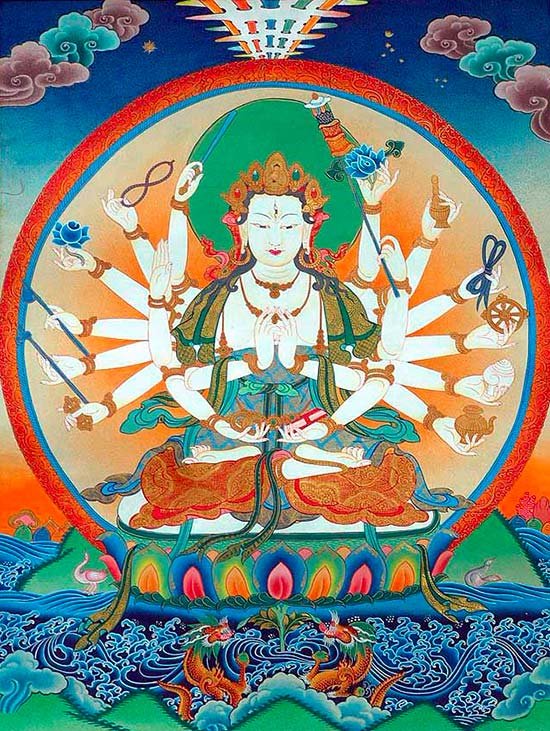Maha Prajnaparamita Sastra
by Gelongma Karma Migme Chödrön | 2001 | 941,039 words
This page describes “the ten spheres of totality (kritsnayatana, kritsna-ayatana)” as written by Nagarjuna in his Maha-prajnaparamita-sastra (lit. “the treatise on the great virtue of wisdom”) in the 2nd century. This book, written in five volumes, represents an encyclopedia on Buddhism as well as a commentary on the Pancavimsatisahasrika Prajnaparamita.
Class 7: The ten spheres of totality (kṛtsnāyatana, kṛtsna-āyatana)
[216c] As for the ten kṛtsnāyatanas ‘spheres of totality of the object’, we have already spoken of them in regard to the vimokṣas and the abhibhvāyatanas. They are called ‘spheres of totality’ because they embrace their object in its totality (ālambanakṛtsnaspharaṇāt).[1]
Question. – [Of the four formless spheres (ārūpyāyatana], only the first two, ākāśānantyāyatana ‘sphere of infinite space’ and vijñānānatyāyatana ‘sphere of infinite consciousness’, are kṛtsnāyatanas. Why are [the other two formless spheres], namely, ākiṃcanāyatana ‘sphere of nothing at all’ and naivasaṃjñānāsaṃjñāyatana ‘sphere of neither identification nor non-identification’] not kṛtsnāyatanas as well?
Answer. – The kṛtsnāyatanas are subjective views (adhimokṣamanasikāra) and, of the formless spheres, only two, those of infinity of space and infinity of consciousness, lend themselves of subjective extensions.
“Safety (yogakṣema), happiness (sukha), vastness (viśāla), immensity (apramāṇa) and infinity (ananta), the sphere of space”, said the Buddha. – Throughout all the kṛtsnāyatanas there is a consciousness (vijñāna) capable of quickly bearing upon all things and, faced with these dharmas, one determines the presence of consciousness. This is why the two spheres (āyatana) [of space and consciousness] constitute the kṛtsnāyatana.
On the other hand, in the sphere of nothing at all (ākiṃcanyāyatana), there is no substance (dhātu) capable of being extended; there is no happiness (sukha) there and, in regard to nothing-at-all, the Buddha said nothing about infinity, immensity.
In the sphere of neither identification nor non-identification (naivasaṃjñānāsaṃjñāyatana), the mind is dull (mṛdu) and it is hard for it to grasp a concept (nimittodgrahaṇa) and extend it to infinity, as is the case for the kṛtsnas].
Furthermore, the ākāśāyatana is close to the form realm (rūpadhātu) and it can still be concerned with visibles (rūpa). The vijñānāyatana also can be concerned with visible objects. Besides, coming out of the vijñānāyatana, one can leap into the fourth dhyāna and, on coming out of the fourth dhyāna, one is able to leap into the vijñānāyatana.[2] On the contrary, the ākiṃcanāyatana and the naivasaṃjñāyatana [as the higher spheres of the ārūpyadhātu] are very distant in formlessness: this is why they are not kṛtsnāyatanas.
Footnotes and references:
[1]:
Cf. Kośavyākhyā, p. 692: Nirantarakṛtsnasspharaṇād iti nirantaraṃ kṛtsnānāṃ pṛthivyādīnaṃ spharaṇād vyāpanāt kṛtsnāyatanānīty ucyante. – Vibhāṣā, T 1545, k. 85, p. 40b18–23: They are called kṛtsnāyatana for two reasons: i) because they are without intervals (nirantara) and ii) because they are extended (viśala). Because deliberate reflection (adhimokṣamanasikāra) bears uniquely on blue, etc., without being mixed with another object, they are ‘without interval’; because deliberate reflection on all of blue, etc., is of infinite scope (gocara), they are ‘extended’. The Bhadanta says: Because their object (ālambana) is vast and extended, because there are no intervals-gaps, they are called kṛtsnāyatanas.
[2]:
A possibility that may be verified during the vyutkrāntakasamāpatti or the ‘absorption of the leap’: see above, p. 1048F, and, for detailed description, see Hôbôgirin, IV, p. 353–360, article Chōjō by J. May.
